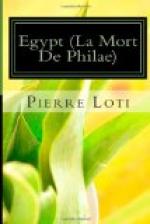The peculiar charm of the gardens of the mosques, which are often very extensive, is that they are so jealously enclosed within their high walls—crowned always with stone trefoils—which completely shut out the hubbub of the outer world. Palm-trees, which have grown there for some hundred years perhaps, rise from the ground, either separately or in superb clusters, and temper the light of the always hot sun on the rose-trees and the flowering hibiscus. There is no noise in the gardens, any more than in the cloisters, for people walk there in sandals and with measured tread. And there are Edens, too, for the birds, who live and sing therein in complete security, even during the services, attracted by the little troughs which the imams fill for their benefit each morning with water from the Nile.
As for the mosque itself it is rarely closed on all sides as are those in the countries of the more sombre Islam of the north. Here in Egypt—since there is no real winter and scarcely ever any rain—one of the sides of the mosque is left completely open to the garden; and the sanctuary is separated from the verdure and the roses only by a simple colonnade. Thus the faithful grouped beneath the palm-trees can pray there equally as well as in the interior of the mosque, since they can see, between the arches, the holy Mihrab.[*]
[*] The Mihrab is a kind of portico indicating the direction of Mecca. It is placed at the end of each mosque, as the altar is in our churches, and the faithful are supposed to face it when they pray.
Oh! this sanctuary seen from the silent garden, this sanctuary in which the pale gold gleams on the old ceiling of cedarwood, and mosaics of mother-of-pearl shine on the walls as if they were embroideries of silver that had been hung there.
There is no faience as in the mosques of Turkey or of Iran. Here it is the triumph of patient mosaic. Mother-of-pearl of all colours, all kinds of marble and of porphyry, cut into myriads of little pieces, precise and equal, and put together again to form the Arab designs, which, never borrowing from the human form, nor indeed from the form of any animal, recall rather those infinitely varied crystals that may be seen under the microscope in a flake of snow. It is always the Mihrab which is decorated with the most elaborate richness; generally little columns of lapis lazuli, intensely blue, rise in relief from it,




